




Quick Links:


Environmental Risk Management is a governance tool to facilitate implementation of University Environment Stewardship policy. It is based on an ISO 14001 certified Environmental Management System (EMS) that covers broad range of University operation's and activities to ensure that adverse environmental impacts of these activities are eliminated or minimized in addition to legal compliance.
Our EMS sets out University wide environmental requirements aligned with local regulatory requirements and international best practiced standards. It communicates these requirements to the University stakeholders through various communication tools including intensive training program.
Compliance to University's environmental requirements is monitored through a planned performance monitoring program consisting of inspection and series of internal and external audit program. Our EMS provides us the opportunity to review and continually improve our environmental performance. The diagram below presents key elements of our EMS.
KAUST EMS is a comprehensive document tailored to manage University environmental impacts. It can be accessed online from this link
Below is a brief summary of each element of EMS.


The Non-compliance and Corrective Action Procedure describes the process to ensure that KAUST establishes, maintains and uses a system to identify non-compliances, and to implement corrective and preventative action processes to monitor, report, investigate and mitigate any impacts caused by the occurrence of potential and actual Non-compliance with the environmental legislation, regulations, policies, procedures and standards.
The primary objective of the Legal and Other Requirements Procedure is to provide a system for identifying the environment related regulation that applies to all core operations and activities of KAUST. This procedure also provides guidance for monitoring and evaluation of compliance with applicable regulatory requirements.
The primary purpose of Environmental Aspect & Impact Management Procedure is to establish a uniform and consistent methodology for identification, evaluation, management and review of environmental impacts associated with KAUST's activities and operations. In addition, this procedure will provide guidance for introducing control measures to either eliminate or reduce environmental impacts.
The primary objective of the Environmental Communication Procedure is to document how organization manages environmental matters related internal communication as well as the communication held with external parties. In addition, this procedure details the environmental meetings hierarchy and information flow within the organization.
KAUST's EMS adopts the KAUST Emergency Management plan in establishing the responsibilities and organizational structure to emergencies impacting the KAUST campus or the community.
The Environmental Performance Monitoring & Reporting Procedure establishes the basic framework and requirements for the systematic annual planning, monitoring, and reporting KAUST environmental management performance. This is the key document that reflect continual improvement of environmental performance year on year.
The Environmental Audits and Inspection Procedure defines KAUST's environmental compliance assurance and evaluation program in order to verify the effectiveness of the EMS at KAUST.
The Management Review Procedure is to describe the type, frequency and level of management review required to evaluate the suitability and effectiveness of the KAUST EMS as well as ensuring its continual improvement.